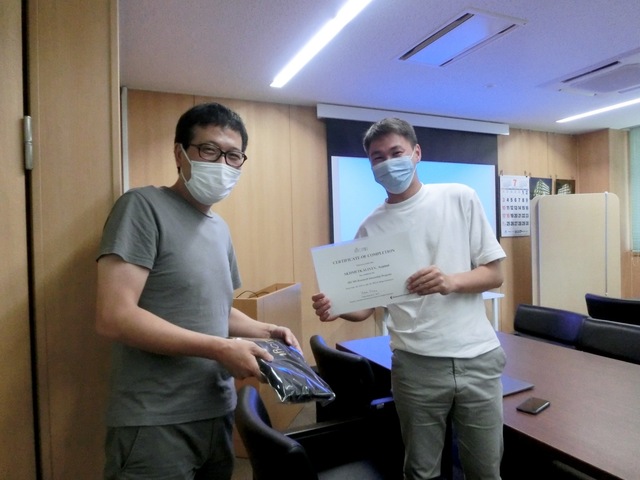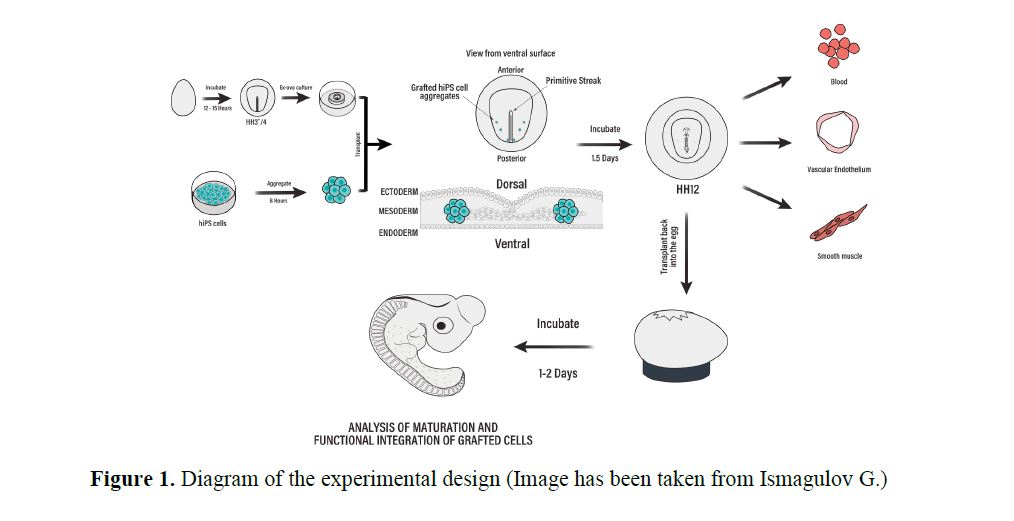- HOME
- Education
- Student's Voice
- 【IRCMS Internship】Mr. Azamat Akhmetkaliyev (Nazarbayev University)
Student's Voice

Name: Azamat Akhmetkaliyev
Nazarbayev University
Visiting Period: June 3rd (Fri) - July 31st (Sat), 2022
Country: Kazakhstan
Manipulation of chicken embryo: analysis of apoptosis in transplanted hiPS cell aggregates and the effect of pH on embryonic development
Chicken embryo is a well-known model system to study development. From historical perspective, major biological concepts in a variety of biological fields from cell biology to cancer were discovered utilizing chicken embryo model (Stern, 2005). It has proved itself to be a versatile model system for developmental studies. Every developmental stage is accessible for manipulation, embryos are available year-long, cells and tissues can be labelled, transplanted and cultured, along with its similarity to mammalian systems (Mok et. al., 2015; Stern, 2005). Moreover, with the discovery of in vivo electroporation and other genetic tools, it is now possible to knock-down, misexpress and edit genes of the embryo, which makes this amazing "model system" even more powerful. In combination with the classical xenografting experiments (Douarin & Joterau, 1975), we can now ask questions about gene functions in the cell-specific context, which cannot be easily studied in other vertebrate model organisms.
Human induced pluripotent stem cells (hiPSCs) can differentiate into all cell types of the adult body. However, their functional integration and maturation upon differentiation in vitro remain challenging (Moradi et. al, 2019). Chicken-human chimera might be a good candidate to investigate the potential of hiPSC differentiation in vivo. For that, Galym Ismagulov, a Ph.D. student in Sheng lab, has established a protocol to create a chicken-human chimeric embryo where he grafted undifferentiated hiPSCs in the developing chicken embryo (Fig. 1). During my internship, we investigated whether transplanted cells survive post-transplantation, where we performed TUNEL staining with chimeric embryos. I have learned how to culture chicken embryos ex ovo using a culture technique developed by Denis New, how to maintain hiPSCs and transplant them in the embryos. In addition, I have been involved in some experiments related to the temperature and pH-mediated hibernation, where we tried to validate some of the differentially expressed genes of interest using in situ hybridization.
Overall, it has been a valuable experience, which allowed me to ask new research questions which I wouldn't have thought about without having the knowledge I gained through this internship program. I have learned how to design and execute experiments with the higher probability of success, learned new techniques and had fruitful discussions that stretched me as a scientist. Getting to interact with some of the scientists and students in the institute was incredible opportunity in terms of next steps in my career. It's hard to put into words how significant this internship was for me, and I'll be forever grateful for that time in IRCMS.
Reference List
Le Douarin, N. M., & Jotereau, F. V. (1975). Tracing of cells of the avian thymus through embryonic life in interspecific chimeras. The Journal of experimental medicine, 142(1), 17-40.
Mok, G. F., Alrefaei, A. F., McColl, J., Grocott, T., & Münsterberg, A. (2015). Chicken as a developmental model. eLS. John Wiley & Sons Ltd, Chichester. https://doi. org/10.1002/9780470015902. a0021543.
Moradi, S., Mahdizadeh, H., Šarić, T., Kim, J., Harati, J., Shahsavarani, H., ... & Moore, J. B. (2019). Research and therapy with induced pluripotent stem cells (iPSCs): social, legal, and ethical considerations. Stem Cell Research & Therapy, 10(1), 1-13.
Stern, C. D. (2005). The chick: a great model system becomes even greater. Developmental cell, 8(1), 9-17.

